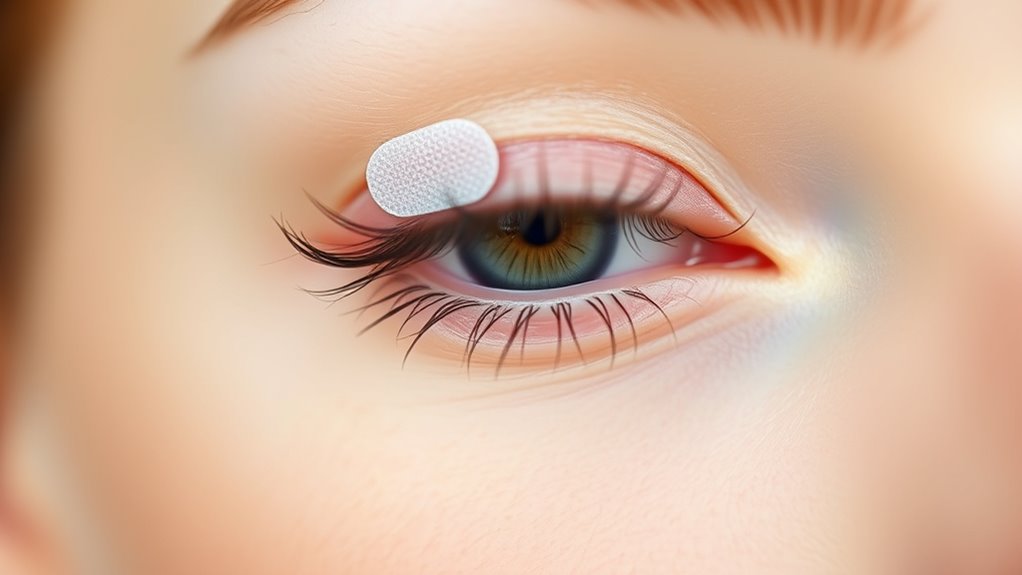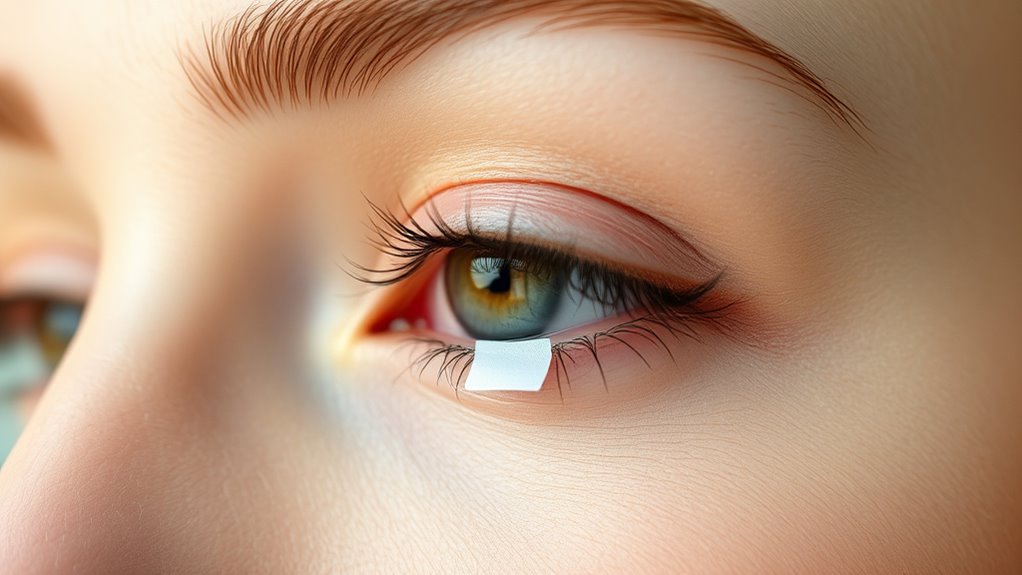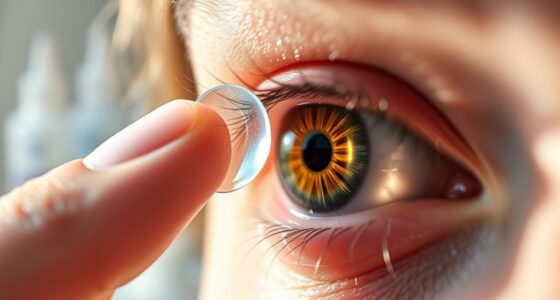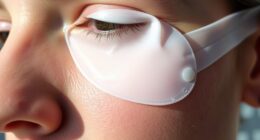To safely patch test around your eyes, apply a small amount of the product or allergen behind your ear or on your inner forearm, then cover it with a patch for 48 hours without washing or rubbing. Watch for redness, itching, or swelling, and remove the patch if any irritation appears. Remember, it’s best to do this under professional supervision to make certain of accurate results and protect your sensitive eye area—more tips await you.
Key Takeaways
- Perform patch tests behind the ear or on the inner forearm before applying products near the eyes.
- Cover the test area with a patch for 48 hours without washing or rubbing.
- Watch for redness, swelling, itching, or blistering and remove the patch if symptoms appear.
- Consult a dermatologist for professional guidance and interpretation of test results.
- Gradually introduce new eye products after successful patch testing to minimize allergy risks.

If you’re considering treatments or products for the delicate eye area, patch testing can help identify potential allergies before you experience irritation. The skin around your eyes is particularly sensitive, so recognizing allergy symptoms early is essential. Performing a patch test before applying new products can save you from uncomfortable reactions and long-term damage.
Understanding the patch testing procedures is fundamental to guarantee safety and accuracy. Typically, a patch test involves placing a small amount of the product or allergen on your skin, usually behind your ear or on your inner forearm, and covering it with a patch or bandage. For eye area products, some specialists might perform the test on a less sensitive area first, or use a specialized method designed for delicate skin. The patch remains in place for 48 hours, during which you should avoid washing or rubbing the area. After the designated time, you’ll remove the patch and observe for any allergy symptoms, such as redness, swelling, itching, or blistering.
By following proper patch testing procedures, you minimize the risk of an adverse reaction and gather valuable information about how your skin responds. During the testing period, keep a close eye on any signs of irritation. If you notice allergy symptoms developing, like persistent redness or swelling, it’s important to consult with a dermatologist immediately. These symptoms indicate that the product or allergen isn’t suitable for your skin and should be avoided.
It’s also essential to remember that patch testing isn’t foolproof. Some allergic reactions can be delayed or may only occur with prolonged exposure. Consequently, even if your initial patch test shows no reaction, be cautious when introducing new eye products gradually. Always perform a patch test with each new product, especially those containing fragrances, preservatives, or active ingredients known to cause sensitivities.
In addition, make certain that the patch testing is performed under professional supervision, especially when testing products intended for sensitive areas like the eyes. A dermatologist or trained skincare specialist can guide you through the process, choose appropriate testing sites, and interpret the results accurately. This professional oversight helps prevent false negatives or positives and guarantees you’re taking the safest approach. Moreover, understanding the electric power generation potential of certain devices can be useful if you incorporate electrical tools into your skincare routine, ensuring safety and effectiveness.
Frequently Asked Questions
Can Patch Testing Cause Long-Term Eye Damage?
Patch testing for the eye area generally doesn’t cause long-term effects if done properly, but there’s a small risk if allergens cause severe reactions. Poor technique or allergic responses can jeopardize eye safety, leading to irritation or damage. To protect your eyes, make certain the test is performed by a trained professional, and monitor for any adverse reactions. This minimizes risks and helps maintain long-term eye health.
How Often Should Patch Testing Be Repeated?
You should repeat patch testing based on your skin’s response and any reactions you’ve experienced. Generally, consider testing intervals of 48-72 hours, but frequency considerations depend on the product and your sensitivity. If you notice any irritation or allergy signs, wait longer before retesting. Always consult a dermatologist to determine personalized testing intervals, especially around the delicate eye area, to avoid unnecessary irritation or damage.
Are There Alternative Methods to Patch Testing?
Imagine avoiding a storm by checking the sky—there are alternative methods to patch testing for allergy detection. You might try home remedies like carefully applying small amounts of products around your eye, then observing reactions. Allergy avoidance remains essential; steer clear of known irritants. While not as precise, these methods can help identify sensitivities without traditional patch testing, but consult a professional for accurate diagnosis and personalized advice.
What Should I Do if I Experience a Reaction?
If you experience an allergy symptoms or a reaction, act quickly. Remove any eye makeup or products immediately and rinse your eyes with cool water. If symptoms worsen or you experience swelling, difficulty breathing, or pain, follow emergency procedures by seeking medical help right away. Don’t delay—your prompt response can prevent more serious complications. Always keep emergency contact numbers handy in case you need urgent medical assistance.
Is Patch Testing Suitable for Children’s Eye Sensitivities?
Did you know that around 20% of children experience allergies, including eye sensitivities? Patch testing can help identify specific triggers for children’s allergies, but it’s not always suitable for sensitive eye areas. You should consult a dermatologist or allergist to determine if patch testing is appropriate for your child’s eye sensitivity. They can guide you on safe testing methods to avoid irritation or adverse reactions in such a delicate area.
Conclusion
Now that you know how to safely patch test around your eyes, you can approach it with confidence. Think of the process like a gentle handshake—trustworthy and careful. By following proper steps, you minimize risks and protect your delicate eye area, ensuring you can enjoy new products without worry. Remember, patience and vigilance are your best friends here, guiding you like a lighthouse guiding a ship safely to shore.









